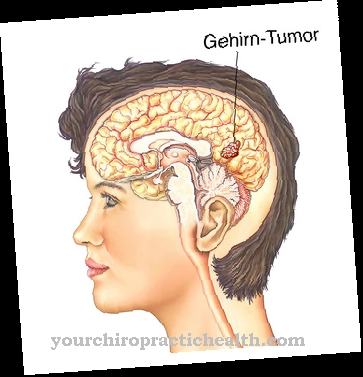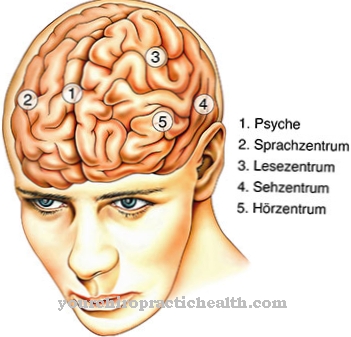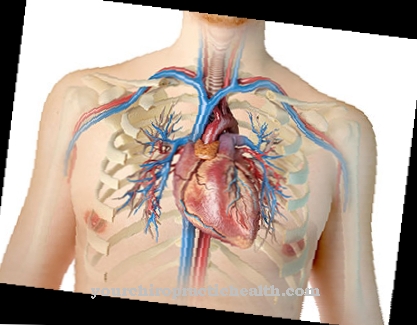The Hand-foot syndrome occurs more frequently in the course of treatments with cytostatics. Patients' feet and hands become red, flaky and painful or have sensory disorders. The hand-foot syndrome is treated symptomatically with painkillers and creams.
What is hand foot syndrome?

© designua - stock.adobe.com
Therapeutic drug treatments are usually associated with different side effects and health risks. Phenomena such as hand-foot syndrome were observed as side effects of cytostatics. Whether there is an indication to administer a certain drug despite these risks depends on the context. For example, cytostatics cause many side effects and are associated with relatively high risks for the patient.
Since they are used in the life-sustaining treatment of malignant cancer, the benefits to the patient ultimately outweigh the benefits. The indication of the means is guaranteed despite all risks and side effects. The syndrome will too HFS, petechial hand-foot syndrome, Glove-sock syndrome or palmar-plantar erythrodysesthesia called and causes erythema in the hands and feet.
Erythema is reddening of the skin that is visible to the naked eye and is due to local hyperemia of the skin tissue. Both children and adults can be affected by the drug-related phenomenon. There are different degrees of severity of the phenomenon. In the most severe cases, the skin on the hands and feet blisters in addition to the redness and the limbs are impaired in their function due to severe pain.
causes
The exact cause or development of the hand-foot syndrome is still unclear. In most cases, hand-foot syndrome occurs after administration of capecitabine, doxorubicin or 5-fluorouracil. There appears to be a causal relationship to the metabolites of fluorouracil. Drugs such as cyclophosphamide, oxaliplatin, cytarabine, paclitaxel, docetaxel, sunitinib and sorafenib can also cause the side effects.
The hand-foot syndrome is therefore often interpreted as an accompanying reaction to antineoplastic chemotherapy. On the other hand, the phenomenon can also occur in the context of blood diseases such as sickle cell anemia. The exact mechanisms underlying the formation of the characteristic erythema is currently still a matter of discussion and speculation.
Although hand-foot syndrome is observed relatively frequently after the administration of the drugs mentioned, it does not necessarily occur. Why some patients develop the erythema and others not remains unclear. So far, the same applies to the factors that favor particularly severe cases.
You can find your medication here
➔ Medicines for paresthesia and circulatory disordersSymptoms, ailments & signs
The hands and soles of the feet of people with hand and foot syndrome become reddened and abnormally tender. Dandruff often forms in the affected areas. In addition, numbness is common. Paresthesia or dysesthesia also occur. The severity of the syndrome can vary in severity.
Depending on the severity, HFS can clinically be divided into three degrees of severity:
- Grade 1 is a painless erythema that is associated with dysesthesia or paresthesia and is not an impairment.
- Grade 2 of the syndrome is painful erythema with swelling that affects everyday life to a certain extent.
- The most severe grade is grade 3. At this severity, damp flaking or peeling of the skin occurs. Blisters form with severe pain. A hand-foot syndrome of the third degree of severity leads to significant impairments of the hands and feet, which hinder the patient in performing everyday processes and thus make it difficult for him to walk or grasp, for example.
diagnosis
Hand-foot syndrome is diagnosed by the doctor on the basis of clinical symptoms and the background of the patient's medical history. In the context of diagnostics, the decisive question is whether the syndrome was triggered by currently administered medication or a disease such as sickle cell anemia. The patient's prognosis depends on the severity of the syndrome and the treatability of the cause.
Complications
The hand-foot syndrome causes severe discomfort to the feet and hands of the patient. In most cases, paralysis and impaired sensation can become noticeable. As a result of these disorders, the everyday life of the person affected is restricted, and movement restrictions may also occur. The pain and restrictions often lead to psychological complaints and depression.
The skin also turns red, it can be affected by itching. It is not uncommon for the skin to flake as well. Due to pain at rest, the hand-foot syndrome can also lead to sleep problems and thus to general irritability. The paralysis may result in severe restrictions in everyday life, so that the patient is dependent on a wheelchair or on the help of other people in order to be able to continue to cope with everyday life.
When treating hand-foot syndrome, the symptoms are primarily alleviated. Causal treatment is only possible if the syndrome is triggered by medication. The treatment usually does not result in any particular complications. However, it cannot be predicted whether the disease will progress positively and whether all symptoms can be completely eliminated.
When should you go to the doctor?
As a rule, the hand-foot syndrome does not heal itself. For this reason, the syndrome should be treated by a doctor in order to avoid worsening symptoms and further complications. The doctor should be consulted if the person's hands or feet are very sensitive to pain. They can also be flaky or reddened. Often numbness is an indication of the hand-foot syndrome and should also be examined by a doctor.
The severity of the symptoms can, however, be very different. Restrictions in movement or in normal and fatal processes can also indicate the disease. If the symptoms persist over a longer period of time and do not go away on their own, you should definitely consult a doctor. An early diagnosis always has a positive effect on the course of the disease.
Usually hand-foot syndrome can be examined by a dermatologist or general practitioner. Further treatment, however, depends on the exact symptoms and is carried out by the respective specialist.
Doctors & therapists in your area
Treatment & Therapy
A causal therapy of a drug-related hand-foot syndrome can only be carried out by changing the medication. If switching is not an option, the syndrome is usually treated symptomatically. Uridine creams, for example, can be used for treatment in this case. Vitamin B6 administration has also been able to improve the symptoms in the past.
If pain is present, patients are also given pain relievers such as paracetamol. Another therapeutic approach is the local supply of glucocorticoids to the skin. Creams containing betamethasone are used for this local therapy. Urea-containing creams can also promise improvement. In addition, the patients are instructed to cool the affected skin regions.
However, cooling usually only relieves symptoms temporarily. As a rule, the treating physicians already apply prophylactic measures as part of the administration of cytostatic drugs, which ideally prevent the symptoms or at least reduce the symptoms. These measures include a number of easy to implement steps.
Outlook & forecast
A uniform prognosis for the hand-foot syndrome cannot be given. This syndrome is not so much an independent disease as a side effect of a therapy that should not be interrupted.
Since the symptoms develop within cancer therapy, the primary disease must be cured and treated. In these cases, it is more important to cure the patient of the potentially life-threatening disease or to take life-prolonging measures if desired.
The hand-foot syndrome is treated symptomatically within the initiated cancer therapy. As long as the treatment of the tumor disease continues, healing of the existing skin changes is almost impossible. The active ingredients that trigger the hand-foot syndrome also alleviate the cancer.
After successful treatment of the cancer, the healing process of the hand-foot syndrome can be intensified. The patient's immune system must be gradually rebuilt. Various creams are used locally to take care of the skin and thus minimize discomfort in the hands and feet.
In addition, various aids help protect hands and feet. The healing process takes several months. Recovery can take several years, depending on the general health of the patient. For some sufferers, only an alleviation of the symptoms of the hand-foot syndrome is achieved.
You can find your medication here
➔ Medicines for paresthesia and circulatory disordersprevention
In order to prevent the hand-foot syndrome as part of cancer therapies, the application of greasy skin ointments is an important step. Patients should avoid contact with hot water during therapy. The same applies to strong mechanical loads on the palms of the hands. For example, scratching and clapping should be avoided, as should the use of hand tools.
Cold water baths ideally take place daily to cool the hands and feet. These baths may be used up to four times a day. In general, excessive stress on the body during therapy with cytostatics is not recommended, as the organism is already exposed to high stresses due to the drug stress.
Aftercare
In the case of hand-foot syndrome, follow-up measures are severely limited in most cases. A purely symptomatic treatment with the help of creams or painkillers, which can certainly alleviate the symptoms. However, the underlying disease of the syndrome must also be treated correctly so that there are no further complications or further worsening of these symptoms.
As soon as the first symptoms or signs of the disease appear, the person affected should therefore consult a doctor. When using the creams or other medications, the patient should always follow the doctor's instructions. It is important to ensure regular use and the correct dosage to counteract the symptoms.
In the case of hand-foot syndrome, contact with other people affected by the disease can often be very useful, as this can lead to an exchange of information. Since the disease often leads to mental upsets or depression, intensive and loving conversations with family or friends are very helpful.
In severe cases, however, intensive psychological therapy is necessary. As a rule, hand and foot syndrome does not have a negative impact on the patient's life expectancy.
You can do that yourself
It has not yet been clarified where the unpleasant changes in the skin come from and so the therapeutic options and the measures to combat the symptoms are limited.
Vitamin B6 and creams with uridine content can alleviate the sometimes severe consequences. Simply cooling the corresponding areas can have a preventive and healing effect on the extent of the impairment. It therefore makes sense to always have cooling pads in the freezer compartment. On the other hand, water that is too warm and hot leads to a considerable worsening of the symptoms and harms the general feeling.
In the evening, it makes sense to take cool hand and foot baths before going to bed and then to apply moisturizing creams, ointments or even Vaseline and possibly put on thin protective cotton gloves. Gloves also help with daily work. Whenever possible, these should be part of everyday clothing. Shoes must not constrict sore feet and should not contribute to worsening symptoms.
In general, excessive strain on the hands and feet should be avoided. Time to regenerate is important, even if it restructures everyday life. The hand-foot syndrome is reversible and sporting activities should be temporarily avoided. If the disease breaks out, it can be discussed with the attending physician to what extent a lowering of the medication dose or a break in therapy can be helpful.



.jpg)
























.jpg)